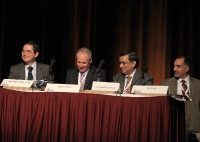News

As urban populations increase worldwide, so does the importance of providing a clean, efficient energy supply and improving standards of living. By 2030, almost five billion people will live in cities, leading to massive requirements for energy to power growth and expand basic infrastructure. Energy efficiency can offer practical solutions to budget-constrained cities to meet their energy needs without sacrificing their development priorities. The Energy Sector Management Assistance Program (ESMAP) participatedin panel discussions of urban planning and energy experts at the just concluded 21st Annual World Energy Congress, in Montreal Canada. The experts described the challenges facing the energy industry in providing for the world’s expanding urban populations at an Energy and Urban Innovation, and Energy Efficiency Policies and Indicators sessions.
ESMAP’s participation in these two World Energy Congress sessions generated an article that was published in the World Energy Congress Daily Magazine. It quoted Jas Singh Senior Energy Specialist, ESMAP as saying that escalating demands for energy access range across a range of sectors, including building and public housing; water and wastewater; transport; public lighting; solid waste; and power and heating. “The priority is on developing key services and expanding access,” he said. “Barriers to energy efficiency – the reasons it doesn’t happen – are spread across many stakeholders.” These include government agencies, service providers, financiers and public end-users, he noted. Where should a city start? According to Singh, many cities begin with retrofitting existing public facilities, next moving to non-public buildings and services, and then integrating “green” urban planning methods.
In discussing procurement options, he added, “The bottom line is there is no one model; we found that for each challenge we identified, there is a full range of approaches that countries have used. Together, these approaches present a continuum of options for the most pressing challenges. For example, many agencies worry that measures that save energy could result in future budget reductions, creating a perverse incentive not to be more efficient. Allowing agencies to retain energy budget savings until they recover their investments or having the parent budgeting agency invest in more energy-efficient systems can help address this problem.”
ESMAP’s Energy Efficient Cities Initiative (EECI) aims to promote energy-efficient programs and planning among cities in developing countries. EECI helps cities apply tools for evaluating systems based on cost, energy use and greenhouse gas profiles, in order to better quantify economic and environmental benefits. It has conducted several analytical studies and developed tools, such as: the Rapid Assessment Frameworkwhich provides a quick, first cut, sectoral analysis on city energy use; Guidelines for public procurement of energy services, which offers guidance on how cities can bundle, finance and implement energy savings projects in bundles of public facilities using energy savings performance contracts; Energy efficient cities assessment tools and benchmarking practicesof a variety of low-carbon, carbon- neutral good practices; and Emerging lessons for mainstreaming building energy efficiency codes in developing countries.
Related links
- ESMAP Presentation at 21st World Energy Congress | Energy and Urban Innovation, Montreal, Canada. September 13, 2010.
- ESMAP Presentation at 21st World Energy Congress | Energy Efficiency Policies and Indicators, Montreal, Canada. September 14, 2010.
Return to EECI Home Page
